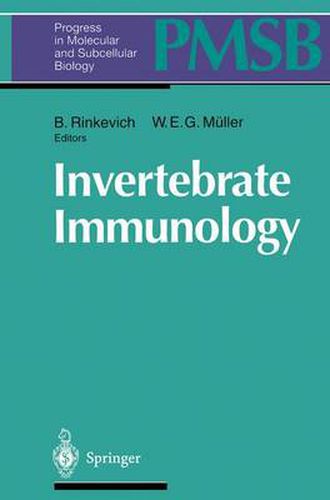Readings Newsletter
Become a Readings Member to make your shopping experience even easier.
Sign in or sign up for free!
You’re not far away from qualifying for FREE standard shipping within Australia
You’ve qualified for FREE standard shipping within Australia
The cart is loading…






This title is printed to order. This book may have been self-published. If so, we cannot guarantee the quality of the content. In the main most books will have gone through the editing process however some may not. We therefore suggest that you be aware of this before ordering this book. If in doubt check either the author or publisher’s details as we are unable to accept any returns unless they are faulty. Please contact us if you have any questions.
The biological bases of invertebrate immune responses have interested scientists for decades, from the first relevant observation by E. Metchnikoff in 1882, who discovered phagocytosis while studying starfish larvae. Invertebrate immunology first began to be appre ciated as an important field in the late 1960s and 1970s. However, in the following years there was much controversy regarding the question: do invertebrates offer insight into the origin of the sophisticated immune responses of the vertebrates? There are several reasons why progress in research on invertebrate immune competence has been painfully slow. One of the main impediments to the progress, as compared to the fast development of knowledge in the vertebrate systems, was the fact that most of the studies concentrated on whole organism assays, mainly on grafting tissues between allogeneic partners. Only in the last few years have more and more aspects of invertebrate immunity been investigated on the cellular, biochemical and molecular levels. These studies led to discoveries of novel defense reactions, new pathways of effector mechanisms which are elicited after recognition of nonself’, and complex, sometimes highly polymorphic genetic elements that control invertebrate immune reactions. The importance of invertebrate immunity for understanding immunology as a whole, despite the conflicting models and hypotheses, is now much more recognized than before. Although most of the 20 phyla belonging to the inver tebrates have different modes of life, body organizations, habitats occupied, and biochemical patterns, they show striking aspects of exceptional precision for discriminating between self and nonself.
$9.00 standard shipping within Australia
FREE standard shipping within Australia for orders over $100.00
Express & International shipping calculated at checkout
This title is printed to order. This book may have been self-published. If so, we cannot guarantee the quality of the content. In the main most books will have gone through the editing process however some may not. We therefore suggest that you be aware of this before ordering this book. If in doubt check either the author or publisher’s details as we are unable to accept any returns unless they are faulty. Please contact us if you have any questions.
The biological bases of invertebrate immune responses have interested scientists for decades, from the first relevant observation by E. Metchnikoff in 1882, who discovered phagocytosis while studying starfish larvae. Invertebrate immunology first began to be appre ciated as an important field in the late 1960s and 1970s. However, in the following years there was much controversy regarding the question: do invertebrates offer insight into the origin of the sophisticated immune responses of the vertebrates? There are several reasons why progress in research on invertebrate immune competence has been painfully slow. One of the main impediments to the progress, as compared to the fast development of knowledge in the vertebrate systems, was the fact that most of the studies concentrated on whole organism assays, mainly on grafting tissues between allogeneic partners. Only in the last few years have more and more aspects of invertebrate immunity been investigated on the cellular, biochemical and molecular levels. These studies led to discoveries of novel defense reactions, new pathways of effector mechanisms which are elicited after recognition of nonself’, and complex, sometimes highly polymorphic genetic elements that control invertebrate immune reactions. The importance of invertebrate immunity for understanding immunology as a whole, despite the conflicting models and hypotheses, is now much more recognized than before. Although most of the 20 phyla belonging to the inver tebrates have different modes of life, body organizations, habitats occupied, and biochemical patterns, they show striking aspects of exceptional precision for discriminating between self and nonself.